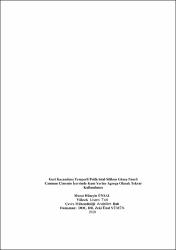| dc.contributor.author | Ünsal, Murat Hüseyin | |
| dc.date.accessioned | 2020-01-14T07:10:09Z | |
| dc.date.available | 2020-01-14T07:10:09Z | |
| dc.date.issued | 2019 | |
| dc.identifier.uri | https://hdl.handle.net/20.500.11776/3417 | |
| dc.description.abstract | Fotovoltaik panellerin ülkemizde giderek kullanımı artmaktadır. Kullanım süresi dolan 20-25 yıllık paneller veya hasarlı panellerin geri dönüştürülmeden doğaya bırakılması doğaya, insana zarar vermesinin yanı sıra materyallerin israfına da yol açmaktadır. Bu panellerden kaynaklı cam atıklarının çevreye verdiği kirlilik önemnli boyutlara ulaşmaktadır. Bu çalışmada, güncel hayatta en yaygın şekilde kullaılan panel modellerinden biri olan polikristal silikon fotovoltaik panellerin geri dönüşümünün çalışılması amaçlanmıştır. Bu kapsamda kullanılan fotovoltaik panelin temperli camları küçük parçalar haline getirildikten sonra, farklı kum oranları ile karışım yapılarak, beton harcı malzemesi olarak kullanılmıştır. Oluşturulan harç numuneleri %0, %5, %10, %15, %20 ve %25 oranında oluşturulmuş ve çimento yapılarak özel kalıplara dökülmüştür. Çalışma ortamımdaki zaman probleminden dolayı yedi günlük piriz süresi beklendikten sonra betonun fiziksel testlerine geçilmiştir. Yeni karışımların yoğunlukları, kullanılan cam partiküllerden dolayı kademeli olarak artış gösterdiği gözlemlenmiştir. Yedi günlük kür süresinden sonra tüm numunelerin basınç testleri yapılarak kontrol numunesi ile kıyaslanmıştır. Bu kıyaslamada %15 oranında temperli fotovoltaik cam içeren numune %3,3 daha fazla bir dayanıma sahip olduğu tespit edilmiştir. Su emme kapasitesi ölçümlerinde ise 7200 dakikalık süre sonunda %5’lik numunenin en fazla, %20’lik numunenin ise en az su emme kapasitesine sahip olduğu tesbit edilmiştir. Açık porozite değerleri kontrol numunesinden daha düşük olduğu anlaşılmıştır. Burada %20 temperli cam içeriği bulunan numunenin en az kılcal poroziteye sahip olduğu anlaşılmıştır. Bu çalışmanın en önemli sonuçlarından biri güneş enerjisi panelerinin temperli camlarının çimento karışımı olarak kullanılmasını öneren çevreci bir proje olmasıdır. Ayrıca çimentoda kullanım oranları arttıkça kılcal su emme oranları azaldığı için temellerde yalıtım bakımından önemnli bir inşaat malzemesidir. Ayrıca %15’lik karışım normal konrol numunesinden daha yüksek dayanıma sahip olması da inşaat açısından önemli bir veri olarak değerlendirilmelidir | en_US |
| dc.description.abstract | Photovoltaic panels are increasingly used in our country. The use of 20-25 years panels or damaged panels, which have expired, are left to be recycled to the environment, causing harm to nature and human as well as wasting of materials. The pollution of the glass wastes caused by these panels to the environment reaches important dimensions. The aim of this study is to investigate the recycling of polycrystalline silicon photovoltaic panels, one of the most widely used panel models in current life. In this context, the tempered glass of the photovoltaic panel was turned into small pieces and mixed with different sand ratios and used as a concrete mortar. The formed mortar samples were formed in 0%, 5%, 10%, 15%, 20% and 25% and cement was poured into special molds. Due to the time problem in my working environment, after seven days of curing time, the physical tests of the concrete were started. It has been observed that the densities of the new mixtures gradually increase due to the glass particles used. After seven days of curing time, pressure tests of all samples were made and compared with the control sample. In this comparison, it was found that the sample containing 15% tempered photovoltaic glass had a strength of 3.3% more. In the water absorption capacity measurements, it was found that 5% of the sample had the highest water absorption capacity and the least 20% sample had the water absorption capacity after 7200 minutes. Open porosity values were found to be lower than the control sample. It was found that the sample with 20% tempered glass content had least capillary porosity. One of the most important results of this study is that it is an environmentally friendly project that recommends the use of tempered glass of solar panels as a cement mixture. In addition, as the usage rates of cement increases, capillary water absorption rates are decreasing and it is an important construction material in terms of insulation. In addition, the 15% mixture should have a higher resistance than the normal control sample and should be considered as important for construction. | en_US |
| dc.language.iso | tur | en_US |
| dc.publisher | Namık Kemal Üniversitesi | en_US |
| dc.rights | info:eu-repo/semantics/openAccess | en_US |
| dc.subject | Polikristal | en_US |
| dc.subject | fotovoltaik | en_US |
| dc.subject | temperli cam | en_US |
| dc.subject | harç | en_US |
| dc.subject | agrega | en_US |
| dc.subject | geri dönüşüm | en_US |
| dc.subject | Polycrystalline | en_US |
| dc.subject | photovoltaic | en_US |
| dc.subject | tempered glass | en_US |
| dc.subject | mortar | en_US |
| dc.subject | aggregate | en_US |
| dc.subject | recycling | en_US |
| dc.title | Geri kazanılmış temperli polikristal silikon güneş paneli camının çimento içerisinde kum yerine agrega olarak tekrar kullanılması | en_US |
| dc.title.alternative | Reusing of Recycled Polycrystalline Silicon Solar Module Glass as Replacement Aggregate in Cement Based System | en_US |
| dc.type | masterThesis | en_US |
| dc.department | Enstitüler, Fen Bilimleri Enstitüsü, Çevre Mühendisliği Ana Bilim Dalı | en_US |
| dc.relation.publicationcategory | Tez | en_US |



















